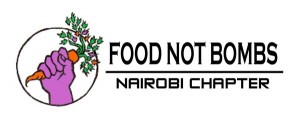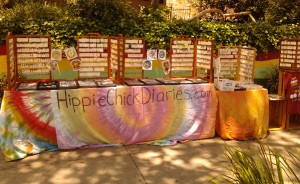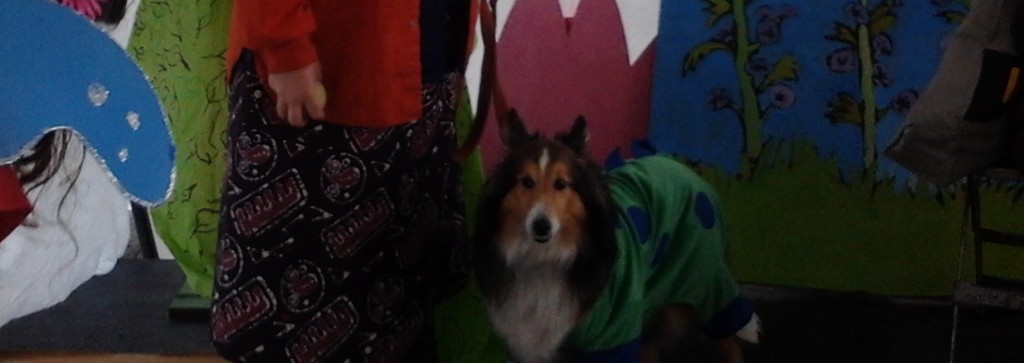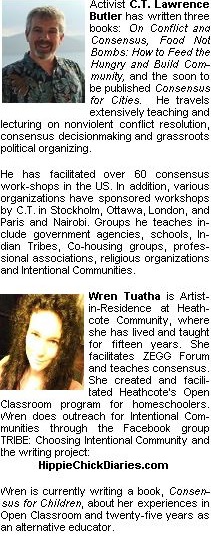Curl Murder: “How Could You Do That to Your Hair?”


 My mother’s desire to be an accepting individual doesn’t mean she’s going to hold her tongue when she has an opinion. In fact, I guess we’re a lot alike that way.
My mother’s desire to be an accepting individual doesn’t mean she’s going to hold her tongue when she has an opinion. In fact, I guess we’re a lot alike that way.
 Even so, I found it ironic that, in the fifteen or more years that I’ve been carrying dreadlocks, she’s often commented on the many nonlocked ways she likes my hair, and how those more socially acceptable ways show off my abundant curls. I find this ironic because she spent my entire childhood trying to comb out said curls, cut them into a bob, or at least train them into little wetted spirals held overnight with bobbie pins, making different curls than the ones that naturally sprout from my scalp.
Even so, I found it ironic that, in the fifteen or more years that I’ve been carrying dreadlocks, she’s often commented on the many nonlocked ways she likes my hair, and how those more socially acceptable ways show off my abundant curls. I find this ironic because she spent my entire childhood trying to comb out said curls, cut them into a bob, or at least train them into little wetted spirals held overnight with bobbie pins, making different curls than the ones that naturally sprout from my scalp.
 I got off easy in the girl-child-of-the-seventies-hair-torture department. My older sister had to sleep in juice can curlers. They weren’t just the size of juice cans, they were actual juice cans with her long, straight hair wrapped around them. My younger sister, also cursed with straight hair, but tender-headed, was subjected to the curling iron.
I got off easy in the girl-child-of-the-seventies-hair-torture department. My older sister had to sleep in juice can curlers. They weren’t just the size of juice cans, they were actual juice cans with her long, straight hair wrapped around them. My younger sister, also cursed with straight hair, but tender-headed, was subjected to the curling iron.
My straight-haired mom went for perms every three months. The perm process took hours. The chemical smell  burned our eyes and left actual burns on the scalp as it burned her hair into whatever curl she wanted. Sometimes she’d dye the gray away, or go for streaks or highlights.
burned our eyes and left actual burns on the scalp as it burned her hair into whatever curl she wanted. Sometimes she’d dye the gray away, or go for streaks or highlights.
Given what mainstream folks do to their hair regularly, I’m perplexed at the occasional weird reaction to a gentle hair practice that involves no chemicals and is rooted in community, familial interaction and connection to nature. But I realize we’re all coming from culture and what’s familiar.
 The other undercurrent of comments from my White friends and family is some good old fashioned curl coveting. If I’m not going to use them, someone else should have them, right?
The other undercurrent of comments from my White friends and family is some good old fashioned curl coveting. If I’m not going to use them, someone else should have them, right?
I’m pensive about the zenophobia that seems to frame the rare brave comment. I was in an elevator in a library in Lexington, Kentucky. A woman asked me about my locks. “They’re different,” She concluded. “To you,” I answered. She thought for a moment. “No, they’re different,” she  repeated. Her world was the entire world.
repeated. Her world was the entire world.
Although such comments are rare, some folks at the York Fair in Pennsylvania really laid it on thick. “You don’t belong here. What country are you from?” My home of nearly twenty years was just twenty minutes from where I was standing, in the country where I’ve lived every day of my life, except for that summer in Spain when I was fifteen and that day my family drove into Canada while visiting Michigan.
 As a matter of fact, a few miles from the York Fair at Spoutwood Farm, I used to attend the annual Faerie Festival. That crowd, sometimes reaching ten thousand in a weekend, was the place where I was least different, surrounded by a high percentage of dreadlocked hippie folk.
As a matter of fact, a few miles from the York Fair at Spoutwood Farm, I used to attend the annual Faerie Festival. That crowd, sometimes reaching ten thousand in a weekend, was the place where I was least different, surrounded by a high percentage of dreadlocked hippie folk.
After the first few years of carrying locks, I was long past concerning myself with the store security guard who followed me around or the eyes that might do  double takes when I entered a room. I was busy living my life. If people did have stereotypes, as soon as I would speak, it was clear that I was not stoned and that I had come to conduct serious business. I was never aware of my hair closing any doors that I wanted to enter.
double takes when I entered a room. I was busy living my life. If people did have stereotypes, as soon as I would speak, it was clear that I was not stoned and that I had come to conduct serious business. I was never aware of my hair closing any doors that I wanted to enter.
But when I began spending time with my partner, C.T., he had an interesting vantage point, walking into a restaurant after me, or watching me in a parking lot. He would see every double take that I was missing because I  was just being myself, and didn’t care. He made a game out of projecting what each onlooker was thinking. It reminded me that with every point of contact, I was adjusting each person’s normal/different continuum.
was just being myself, and didn’t care. He made a game out of projecting what each onlooker was thinking. It reminded me that with every point of contact, I was adjusting each person’s normal/different continuum.
I like the tradition of working (maintaining) locks as a familial or communal practice. When I started my first set, I threw a party and asked my Heathcote Community mates to start them. I got some feedback that this felt odd or self absorbed. So I established the next set  myself. I did teach C.T. to maintain my locks and when they grew so long and heavy that I was having neck pain, he ritually cut them for me, symbolizing also, the end of our time with Occupy Wall Street. Now he’s helping me start a new set.
myself. I did teach C.T. to maintain my locks and when they grew so long and heavy that I was having neck pain, he ritually cut them for me, symbolizing also, the end of our time with Occupy Wall Street. Now he’s helping me start a new set.
This is the set of locks I’ll carry as I go gray, as C.T. and I go deeper in our relationship and our teaching of consensus. What new places and people will add their energy to these locks? Our dog will grow old and die. Will we  make it to California? Where will we put down roots and establish our consensus institute?
make it to California? Where will we put down roots and establish our consensus institute?
In this time of new beginnings, it is time to begin new dreadlocks.
—WT
Subscribe to this blog's RSS feed
A Well-Fed Kenya: Food and Photojournalism
 Some stories enter my bones and don’t leave. The story of Nairobi Food Not Bombs is in my marrow and vibrating, refusing to be ignored.
Some stories enter my bones and don’t leave. The story of Nairobi Food Not Bombs is in my marrow and vibrating, refusing to be ignored.
As C.T.’s partner, I’m a witness to the daily news feed of Food Not Bombs arrests and court cases, mostly here in the U.S. In addition, he gets a steady stream of calls all day, mostly people asking advice on consensus and also starting a Food Not Bombs.
One such FNB startup was germinated from C.T.’s trip to Nairobi, Kenya, in 2007. He was there to teach consensus at the IndyMedia Convergence, in advance of the World Social Forum.
IndyMedia is an amazing case study in do-it-yourself journalism, personal and collective empowerment. IMC “converges” at the site of each World Social Forum, a week or so before the WSF begins, to teach grassroots journalism to non-corporate press from all over the world.
The convergences are temporary Intentional Communities that operate by consensus. Workshops teach would be journalists from Africa, South and Central America, Europe and the U.S. in street-level skills like building radios and transmitters out of materials available where they live.
At the Nairobi convergence, C.T. taught consensus and also pulled a hidden skill out of his hat—He taught IMC participants how to build a silkscreen press! This knowledge came from his early days of battling

C.T. teaches IMC journalists how to build and use a 3-color silkscreen press to generate fliers, books, posters, t-shirts, etc.
Seabrook Nuclear Power Plant, starting the first FNB collective, the start of ACTUP, etc.
The convergences are meetings of very different cultures. In Nairobi, C.T. was the “old guy.” While the Northerners (Europeans and Americans) gave him little rank and dismissed his efforts to teach, Africans sought him out and revered him as the elder in the group.
One such new friend erased C.T.’s name from a community chore chart and wrote his own in its place. “In my culture, elders do not do the dishes,” He said.
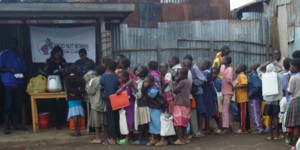 Douglas Rori, a convergence participant who was local to Nairobi, was so taken by C.T.’s stories of Food Not Bombs that he started a Nairobi chapter.
Douglas Rori, a convergence participant who was local to Nairobi, was so taken by C.T.’s stories of Food Not Bombs that he started a Nairobi chapter.
A Totally Different Ballgame
But unlike the twentysomethings who start chapters in their Midwestern college towns or face up against the police in Tampa, Florida, Doug and his Nairobi compatriots couldn’t just show up in the town square or public park with a table and pots of yummy vegan soup.
That’s a recipe for a food riot.
The hunger issue is not a minority issue there. Public feedings such as FNB is famous for the world over would put Doug and other volunteers at physical risk. Plus, with their food stolen, they would not complete their goal of serving the large population of street kids, mostly orphaned in the AIDS epidemic.
Sewing in the IndyMedia Thread
This is where the story gets dramatic in order to prevent drama.
Doug and other young Kenyan activists had the direct experience of how empowering it is to learn tools for telling personal and local stories; to be an alternative to the corporate press party line.
And they had learned filmmaking, photography and journalism in that way. Doug decided to disguise their feedings by offering journalism workshops to the homeless kids.
They chose enclosed courtyards and indoor spaces and spread the word about their workshops. As you can see by the photos, people of all ages came to learn.
And meals were included!
To keep this innovative project going, Doug has formed an NGO, A Well-Fed Kenya, in partnership with A Well-Fed World. This status enables him to operate and seeking funding on an ongoing basis.
Even with NGO status, life is still touch and go for Doug. An IndyMedia colleague was gunned down a few months ago in one of the ghettos, probably an assassination. Doug himself struggles to keep a roof over his own head as he does this important work.
To fund his project and stability for the coming months, we have collaborated with him on an Indiegogo campaign. Please
CLICK HERE TO VISIT OUR CAMPAIGN PAGE,
make whatever contribution you can, and tell your friends Doug’s amazing story! Let’s pull together to keep this project going in the ghettos of Nairobi!
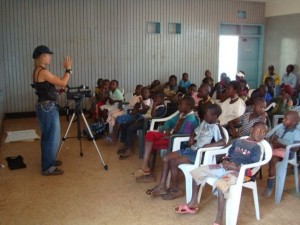 We are starting out with some popular perks from our previous Indiegogo campaign, Food Not Bombs t-shirts and copies of C.T.’s books, On Conflict and Consensus and Consensus for Cities.
We are starting out with some popular perks from our previous Indiegogo campaign, Food Not Bombs t-shirts and copies of C.T.’s books, On Conflict and Consensus and Consensus for Cities.
Doug is also making contact with some fair trade crafts cooperatives and exporters in Nairobi who may be willing to donate some of their jewelry and other crafts as perks for the campaign. So watch for additional perks!!!
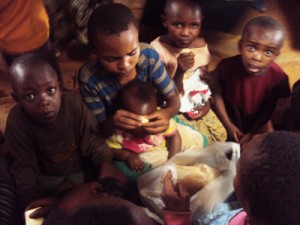 How can you get involved? Certainly, donating whatever you can is a huge start. Are you willing to join our campaign team and use Indiegogo share tools and social media to spread the word? Reaching out to people who don’t already know me, C.T. or Doug Rori is a great help.
How can you get involved? Certainly, donating whatever you can is a huge start. Are you willing to join our campaign team and use Indiegogo share tools and social media to spread the word? Reaching out to people who don’t already know me, C.T. or Doug Rori is a great help.
What ideas do you have for getting the word out about this impactful project?
If you’re in the D.C. region, C.T. and I can schedule a House Party with you. We can supply a slide show, talk about the project with friends you invite, and seek donations. Contact us at fiopa@consensus.net today to make arrangements!
Our main goals for now are to share this amazing story of risk, caring and daring and to get folks to visit our campaign page and donate. We must keep this work going!
When visiting the campaign site, do take the time to go through the photo gallery picture by picture. The interest of the kids in learning from Doug and his friends is amazing. You will understand from the numbers of people who attend that his offering is relevant and is making a difference.
What can you give today?
Tuesday, Wednesday & Thursday Nights: 3 Livestream Interviews with C.T. Butler
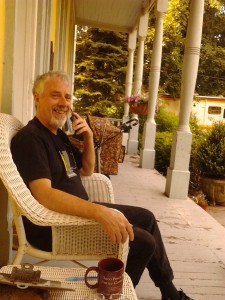 TUES, WED & THURS nights at 8pm EDT (July 10-12, 2012):
TUES, WED & THURS nights at 8pm EDT (July 10-12, 2012):
Looking at my collection of Direct Democracy Tour camera phone shots, I am amused at how often I catch C.T. talking on the phone. My theory is that when he takes calls to consult on consensus process, I often see that as a break in our work and I whip out the phone for candid shots around whatever house we’re staying in. It’s getting to be some kind of photographic meme, however.
We have regular callers and one-timers. Regulars call from Occupy hot spots in the Bay Area, New York, Boston, Atlanta and Philly. Food Not Bombs activists call from Boston, Orlando and Nairobi.
Some of those calls are not activists asking how to deal with disruptors, but radio and podcast interviews. 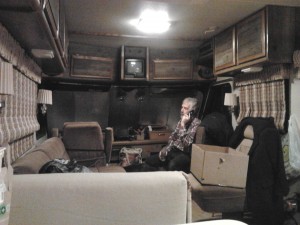 C.T. gives great radio through his four year old cellphone. Sometimes we trek into a studio for a face to face interview. This week, it’s Skype.
C.T. gives great radio through his four year old cellphone. Sometimes we trek into a studio for a face to face interview. This week, it’s Skype.
This week OPN, Other Possibilities Network, is doing a series of livestream interviews with C.T.. OPN host Mark (“Artister”) will break up the nights with the following topics. I know many of you know the resume details, but for those who don’t, here they are:
•Tuesday night the topic will be Overview and Observations from a Life in Activism. C.T. has been a central organizer of the post-Clamshell Coalition for Direct Action at Seabrook, Food Not Bombs, ACT UP, the Pledge of Resistance and more. C.T. has been to over five-hundred protests. He’s been arrested over fifty times in non-violent direct actions, and was beaten unconscious by police four times. Most recently he and I have been full time with the Occupy movement.
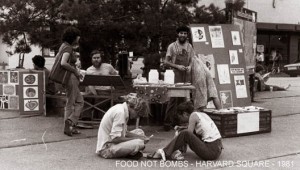 •Wednesday night will be a detailed discussion about the Food Not Bombs movement. C.T. and others from his Seabrook affinity group co-founded the first Food Not Bombs collective house and started the meme that has gone around the world. With Keith McHenry he is co-author of Food Not Bombs: How to Feed the Hungry and Build Community.
•Wednesday night will be a detailed discussion about the Food Not Bombs movement. C.T. and others from his Seabrook affinity group co-founded the first Food Not Bombs collective house and started the meme that has gone around the world. With Keith McHenry he is co-author of Food Not Bombs: How to Feed the Hungry and Build Community.
•Thursday night will be an in depth discussion on 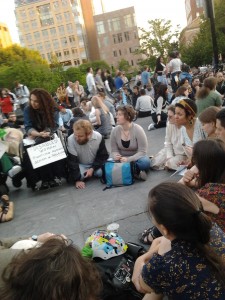 Value-Based Consensus Decisionmaking. As an activist and organizer, C.T. developed an interest in how groups can work together better. He has attended thousands of meetings, sometimes over one-thousand in a single year. 2012 is the twenty-fifth anniversary of his seminal work, On Conflict and Consensus, detailing how to practice Value-Based (formerly “formal”) consensus. C.T.’s latest book, Consensus for Cities, outlines how to use the affinity group/spokescouncil model to practice consensus in groups of up to one-hundred thousand or more. Since October, 2011, C.T. and I have been on our Direct Democracy Tour, offering workshops in consensus and organizing to Occupy groups.
Value-Based Consensus Decisionmaking. As an activist and organizer, C.T. developed an interest in how groups can work together better. He has attended thousands of meetings, sometimes over one-thousand in a single year. 2012 is the twenty-fifth anniversary of his seminal work, On Conflict and Consensus, detailing how to practice Value-Based (formerly “formal”) consensus. C.T.’s latest book, Consensus for Cities, outlines how to use the affinity group/spokescouncil model to practice consensus in groups of up to one-hundred thousand or more. Since October, 2011, C.T. and I have been on our Direct Democracy Tour, offering workshops in consensus and organizing to Occupy groups.
All shows begin at 8pm EDT. Artister’s invitation: “Please join us for what is certain to be an informative and educational week!”
In our “back office” this week, we’re organizing a Consensus: Body and Soul workshop with the Black Cat Collective/Anarchist Bookstore in Dallas/Ft. Worth, Texas. If you’re in Texas or can get there this fall, and want to join in, contact me, Wren, at fiopa@consensus.net!
Also, we’ll be attending the Communities Conference at Twin Oaks in Louisa, Virginia. We’ll be presenting something but we haven’t visioned that yet. Twin Oaks organizers are keen to have an Occupy focus, and I know at least one Occupy activist who’s chompin’ at the bit to merge the Intentional Communities movement with Occupy. Since C.T. and I have been pointing out lately that Intentional Community is where we’ve seen consensus go the deepest, this merger isn’t a crazy idea. See you there Labor Day weekend, August 31 through September 3, 2012!
—WT
Please join our Hippie Chick Diaries fan page on facebook.
Jewelry in June
Time flies! It looks like I’ve been neglecting my blog duties while we transition from our Direct Democracy Tour to a summer schedule.
Summer for us looks like touring flea markets and festivals with my jewelry, a trip to the ocean, dance camp and a consensus workshop in Dallas/Fort Worth, Texas…About a month in each place—July in Washington, DC; August in Maine; September in Texas.
But June is all about jewelry on Staten Island.
I’ve been partnering with some of my friends at Ganas Community here to feature earrings and necklaces I made for Heathcote Earthings, and had left over from that business. I’ve been putting my collections front and center, on the sidewalk outside of Every Thing Goes Clothing on Bay Street. For most of the month I’ve been there two days a week. But now that we’re getting to the end of our stay on Staten Island, I’ve increased my days there and added a couple of other events around town.
Just when I’ve cultivated a loyal following of repeat customers, it’s time to go! Figure…
Here are the remaining dates for Every Thing Goes Clothing (thrift & vintage) at 140 Bay Street:
• TODAY! Saturday, June 23
• Tuesday, June 26
• Wednesday, June 27
• Thursday, June 28
• Friday, June 29
In addition, I’ve arranged two other jewelry set ups at Staten Island events:
• Sunday, June 24—Staten Island Flea Market
• Saturday, June 30—March of Dimes Arts & Crafts Festival, Clove Lake Park
 Our travels continue to be true adventures, with unexpected events around every corner. Yesterday, we learned that the Magic Box, our current Honda CRV, needs many more repairs than is practical for a long range vehicle. We’ll be selling her her on the island and proceeding into the summer with just Serenity, our thirty-four foot Bounder rv. How long will we be without a car? It’s a surprise!
Our travels continue to be true adventures, with unexpected events around every corner. Yesterday, we learned that the Magic Box, our current Honda CRV, needs many more repairs than is practical for a long range vehicle. We’ll be selling her her on the island and proceeding into the summer with just Serenity, our thirty-four foot Bounder rv. How long will we be without a car? It’s a surprise!
Currently, our jewelry/recreational tour looks like:
• July in Washington, DC, visiting friends and looking for work
• August in Maine and New Hampshire, visiting family and attending Dance New England, with a trip to Assateague worked in
• September in Texas, teaching Consensus: Body and Soul to the Black Cat Collective and others, with a possible trip to Washington State to help facilitate the sign language interpreters’ society’s annual meeting
—WT
Please join our Hippie Chick Diaries fan page on facebook!
Dragons Are Not Afraid of Thunder, or A Fine Time at the St. George Day Festival
How do I end up in a pet dragon contest when I’m supposed to be coteaching a consensus workshop in Philadelphia? My life is like a road movie, just a string of random randomness.
Having postponed a workshop in Philadelphia, C.T. and I found ourselves with time to volunteer for and attend the St. George Day Festival here on Staten Island, our new home for a while. The event is organized by our friends at Every Thing Goes Book Cafe and Neighborhood Stage. The cafe is one of several businesses run by Ganas Community. We had been looking for time to plug in. So, with our schedule cleared and despite predictions of rain, plug we did.
 After our own battles with a printer dragon that wouldn’t give us the brochures we wanted, we hiked over to Ganas to help transport food. Once at the festival site, we were assigned the art project of reinforcing the bent fire and scales on a cardboard
After our own battles with a printer dragon that wouldn’t give us the brochures we wanted, we hiked over to Ganas to help transport food. Once at the festival site, we were assigned the art project of reinforcing the bent fire and scales on a cardboard  dragon for the parade. I can’t say that we improved it much, but the dragon did march and we enjoyed seeing our small work in the show.
dragon for the parade. I can’t say that we improved it much, but the dragon did march and we enjoyed seeing our small work in the show.
We helped staff the local authors table. It was interesting to see the range of books and listen to the authors read. Our own books were a little out of place there. But soon we got an invitation from the Green Bus folks, who knew of C.T.’s work with Food Not Bombs. So our materials moved. C.T. had a great time swapping stories with activists from Occupy Wall Street, Occupy Staten Island, Food Not Bombs and more.
Around that time, we found out that there was to be a pet dragon contest. As it turns out, we have a pet dragon, at least part time, specifically when it thunders.
Our sheltie Tuatha is powerful afraid of storms. And fireworks…and any other stimulation that dogs of the ages have ever tried to fear. I saw the ads for the so called “thundershirts,” and I was intrigued but skeptical, especially because the marketing included lots of fake blogs pretending to be independent testimonials.
The ads/blogs implied that the science behind the thundershirt is that it presses on certain acupuncture points on the dog, calming and making her/him feel more secure. Well, that sounds reasonable, but I couldn’t quite justify the expense without knowing it would work on my particular paranoid pup.
That’s when I remembered that Tuatha has a huge collection of Halloween costumes. I knew right away that our favorite, the dragon, would fit snugly in the way that the thundershirts in the pictures do. I tried it the very next time it stormed.
It worked. I would like to tell you a story of false advertising and how they’re just stealing your money. Well, if you have a drawer full of doggie Halloween costumes, it might be the case that you don’t need to give the thundershirt people your money. Don’t ask me how it works. C.T. and I have this whole theory about “contingent behavior” that I won’t go into here.
But the short story is that C.T. went home and got our pet dragon in time for the contest. Because the start time was delayed repeatedly, Tuatha the dragon and I walked all around the festival. He was very popular. We got to meet another contestant, Shakespeare, and his humans who were waiting in the wings. I learned more pointers than I will ever be able to blog about how to win dog contests and where to find them. It turns out the competition was professional!
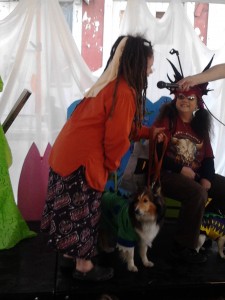 Well, this was only our second contest, the first being a parade in New Freedom, Pennsylvania. We found out about that one the day of. And now the pro’s had a leg up on us again! Shakespeare’s humans velcroed him into a much more elaborate dragon costume, one that didn’t look like he’d worn it for years of trick or treating, hours of playground wrestling and many episodes of thunder.
Well, this was only our second contest, the first being a parade in New Freedom, Pennsylvania. We found out about that one the day of. And now the pro’s had a leg up on us again! Shakespeare’s humans velcroed him into a much more elaborate dragon costume, one that didn’t look like he’d worn it for years of trick or treating, hours of playground wrestling and many episodes of thunder.
But, luck was on our side. It turned out that Shakespeare and Tuatha were the only entrants. And after applause voting (which I’m pretty sure went in Tuatha’s favor) the emcee declared a tie for first place! Fair enough. We got to win!
In other news of the day, we only sold one book but we met many interesting neighbors who would like to learn consensus. And we reconnected with old friends of Ganas Community. We took in interesting poetry and loads of fine local music. And the organizers fed the volunteers a wonderful spread, so we economized there. Very helpful in our line of work.
And we returned to our host’s home with bragging rights—We won the pet dragon contest. What? No state and nationals to follow? That suits Tuatha fine. He loves the idea of going with us when we leave home, but he’s not always thrilled at the places we go. Costumed crowds are no fetish of his.
—WT
Discovering the Secret World of Strollers
 I never would have come up with this one on my own. But as I have found my way through the rivers of people in New York City, I’ve discovered that owners of dogs, particularly small dogs, travel the sidewalks and subways with their pets in purses, totes and, get ready for it, doggie strollers.
I never would have come up with this one on my own. But as I have found my way through the rivers of people in New York City, I’ve discovered that owners of dogs, particularly small dogs, travel the sidewalks and subways with their pets in purses, totes and, get ready for it, doggie strollers.
I don’t necessarily see it every time I get on the subway, but from time to time, there’s Fifi, parked under Mama’s arm, contained in a tote with a mesh window. I would never have envisioned this, even though I am a dog mama and a new immigrant to the really, really, really Big Apple.
I am a reluctant resident at best. Work keeps me here for a few months. My partner C.T. and I have a host who’s opened his Staten Island home to us and our dog, Tuatha. But we want to be able to take Tuatha to Occupy and other outdoor events, and to visit friends, etc.
So as we moved to Staten Island, we took the plunge and ordered a doggie stroller. The experience of shopping online and ordering was simple enough. Not all strollers are created equal; You get what you pay for, etc. I needed a fairly large one for my twenty-nine pound Sheltie, but bigger costs more. After much hunting we found one that fits his frame and has larger, sturdy wheels, a requirement of mine after years of pushing human strollers. An added bonus: Camouflage fabric! I never cease to be amused at camouflage in unexpected or ironic places. My favorite used to be my camouflage cloth menstrual pads, but the fru-fru dog stroller beats that hands down, if only because few people notice what cloth menstrual pad I’m wearing….Sigh.
The stroller was delivered to a friend’s house in Brooklyn. So before we took it home, we used it to carry C.T.’s consensus books to an Occupy event in Central Park. This was when I learned about stroller culture, and the secret tribe of people who know stroller ways.
First, people made way for me, held doors for me and made adoring looks at me, even though the stroller was empty. In the subway, when an escalator was broken someone grabbed the front of the stroller and carefully helped me carry it down the stairs while carefully keeping it level, so as not to wake the sleeping…books and flowchart handouts.
Sitting on the subway or in a restaurant, I would notice a human toddler in a stroller staring at me with a mommy vibe, as if I must know mommy things because I am sitting next to a stroller.
Just as other people with dreadlocks make eye contact with me and give a knowing nod, now so would stroller people. All this while I was pushing books.
 Once at home, just presenting the new conveyance to Tuatha was worth the investment. I wish I had videotaped it. Tuatha was like a kid who’s letter to Santa got answered. He seemed to know what it was for and that it was his, before we even put him inside. He circled it, chirping and nipping at it, then rushing between me and C.T. to nuzzle and kiss. He was sooo thrilled! It was as if he saw this thing with wheels that was his size, and he just knew he’d been given his first car.
Once at home, just presenting the new conveyance to Tuatha was worth the investment. I wish I had videotaped it. Tuatha was like a kid who’s letter to Santa got answered. He seemed to know what it was for and that it was his, before we even put him inside. He circled it, chirping and nipping at it, then rushing between me and C.T. to nuzzle and kiss. He was sooo thrilled! It was as if he saw this thing with wheels that was his size, and he just knew he’d been given his first car.
When we put him inside and velcroed the mesh cover around him, he sat beaming. And he was unphased by the first movement, and the bumps in the driveway. He just looked at us through the mesh window in the top, and checked our location through his side view, and he was good to go, go, go.
Knowing that we wanted to eventually take him on public transportation, we decided to first take him to a park, creating positive associations. Even though he didn’t need to ride in the stroller to the nearest park, he did so, and loved every moment, not even missing all the poles and bushes he would have wanted to mark.
At the park, he got out, played fetch, relaxed with us, and then got a stroller ride home. Perfect! Next, a dry run on the ferry.
The Staten Island Ferry is free, and just a few blocks from our house. So when we need to go to work downtown we are able to walk to the dock, take the ferry and then we’re in Manhattan. Our only transportation cost is the subway. Before, when we were staying far out on Long Island, a trip into the city cost the two of us nearly $100, between the Long Island Railroad, subways and food.
So a ferry ride, our first experiment with Tuatha and public transportation, would only cost us our time. We walked him by leash to the ferry terminal, put him in the stroller and onto the ferry. The only surprise was that Tuatha became unhappy when his stroller was not being pushed. When we stood still in line and when we were in our seats on the ferry, he complained. He wanted us to make his little car go!
On the sidewalk, and in line for the ferry, some people would look inside the stroller to discover that our child was a dog. It’s funny. There are people who will look in strollers and those who just don’t. Tuatha got many ooohs and ahhhs everywhere he went. I’m sure there were people who thought it was terrible, but no one confronted us.
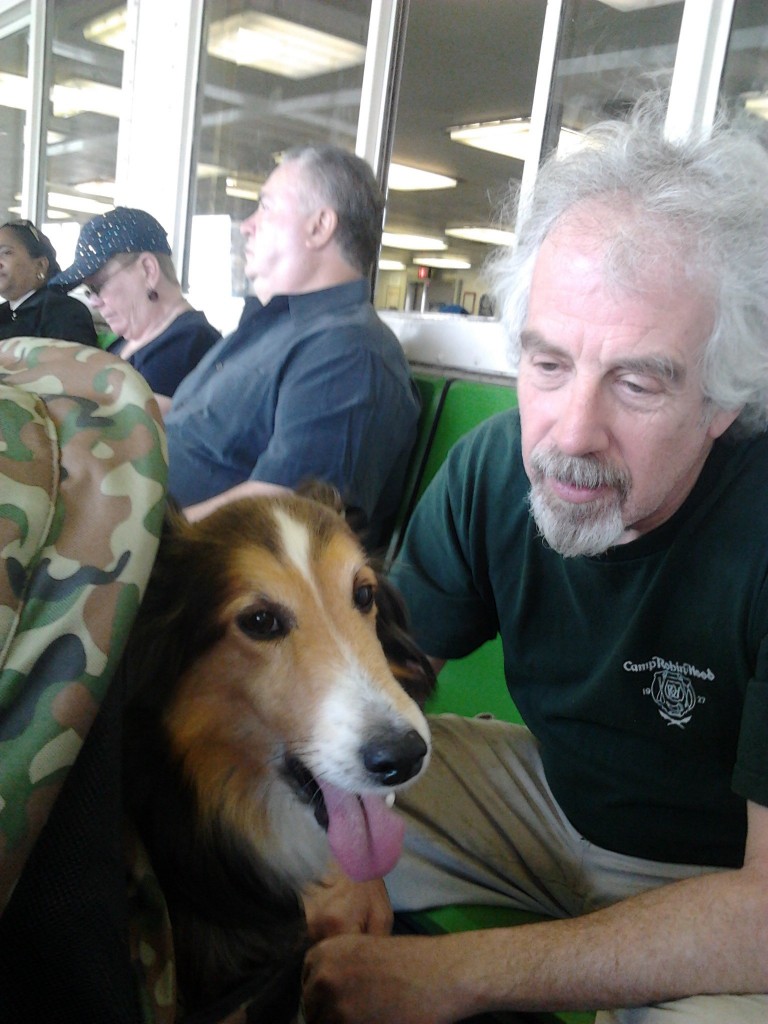 Having ridden the ferry about a dozen times before Tuatha got on, I was worried that the loud foghorn would scare him. Same for the scrape that the ferry makes against the wood pier when it docks. So we made sure to be on the far side of the ferry from those stimuli. Otherwise, the ferry’s motions and engine sounds were gentle enough that Tuatha seemed unphased. Just bored that his car had stopped!
Having ridden the ferry about a dozen times before Tuatha got on, I was worried that the loud foghorn would scare him. Same for the scrape that the ferry makes against the wood pier when it docks. So we made sure to be on the far side of the ferry from those stimuli. Otherwise, the ferry’s motions and engine sounds were gentle enough that Tuatha seemed unphased. Just bored that his car had stopped!
On the Manhattan side, we wheeled him off for a nice relaxing picnic in Battery Park next to the ferry terminal. Since it’s New York, there was no finding a bench for just ourselves, so Tuatha worked on bribing the people on either side of us into sharing their bread. He has a bread addiction. And this was a park where his drug of choice could be had. He didn’t score, but he tried.
Next we’ll have to venture onto the subway with him, during some off peak time. The subway is much louder but, given how well he’s taken to stroller travel so far, he may avoid panic by feeling secure in his enclosure. I won’t push the issue if he doesn’t like it, of course.
But I already consider the stroller experiment successful, not because it provides me with flexibility, but because Tuatha gets such a kick out of it! I strolled him to the fruit stand the other day and he could roll through the open air market with me, complaining when I stopped to examine produce. I put my selections on top of the stroller and put my purchases in the storage bin underneath for the stroll home.
One challenge is that our host’s house is at the top of a long, steep hill that empties into the bay. So every trip everywhere starts with a long walk down and ends with a long walk up. But if Tuatha and I make more trips to the produce stand for fewer things, I get more exercise in the long run, and let no one dispute that I need exercise.
Already I have date set for tomorrow. Tuatha and I will stroll with a friend from Ganas Community. C.T. and I are lucky to be just a few blocks away from an Intentional Community where we know many people. Some of them are, I believe, stroller people…
From Laird Schaub: How Strong to Make the Safety Net
 From Wren: Laird Schaub is a friend from Sandhill Community in Missouri, who teaches facilitation and consensus. He’s active in Fellowship for Intentional Community. Thanks, Laird, for allowing me to repost your article!
From Wren: Laird Schaub is a friend from Sandhill Community in Missouri, who teaches facilitation and consensus. He’s active in Fellowship for Intentional Community. Thanks, Laird, for allowing me to repost your article!
____________________________
About 12 years ago I recall the first time FIC discussed the potential for intentional communities providing a safety net for people with special needs. Under Reagan’s tenure in the ’80s, the federal government went through a massive policy change whereby support for disadvantaged groups was deinstitutionalized. With the Boomer population about to enter retirement age, it didn’t take a math degree to predict the coming train wreck. Why couldn’t communities pick up some of the slack?
There’s no doubt that communities are well structured to offer this kind of help (think about the challenges of aging, mental health, developmental disabilities, physical disabilities, recovery from trauma—there are myriad populations that could benefit from the dignity and caring distinctly possible in group settings). That said, I want to explore the tender dynamics of why it’s hard to take that very far, unless the community makes an explicit choice to go in that direction.
To be sure, there are a number of communities that have chosen to define themselves based on services to disadvantaged segments of the population. Here’s a sampling of some well-established examples:
o Camphill Villages
Inspired by the philosophy of Rudolph Steiner, these groups offer residential support for the developmentally disabled and have been around for 50 years. There are currently 13 offerings in North America, with others abroad.
o Gould Farm
This community in Monterey MA provides residential therapeutic treatment for the mentally ill. It’s been around since 1913—two wall calendars short of a century!
o Innisfree Village
This community in Crozet VA offers support for people with intellectual disabilities and is celebrating its 40th anniversary this year.
o L’Arche
Inspired by the writings of Jean Vanier, this movement started in France in 1964, got a foothold in the US in 1972, and has 17 residential communities in America today, servicing those with intellectual disabilities.
With these solid examples, couldn’t the wider Communities Movement do more on a less formal basis? Perhaps.
Addition by Subtraction
For the most part, intentional communities aim to create a superior lifestyle for their members by purposefully downshifting into the slower lanes of traffic. Community living encourages members to get off the production and consumption treadmill, to slow down, build smaller houses, nurture connections, and share more. Following this path leads to less doing and more being, crafting a quality life on fewer resources. Sure people want security, but this is increasingly being defined as the quality of one’s relationships, rather than the quantity of one’s bank account.
Thus, even as communities aspire to meet their own financial needs, they actively work to whittle down what those needs are, and don’t particularly aspire to make much more than they need.
While most groups willingly stretch to help their own members in need, it is uphill asking communities to set aside resources (or work harder to generate those resources) for the purpose of creating surplus to aid unknown future members. Groups almost never run short of good ideas about how to put surplus resources to use. And if, for some reason, they’re ideas are fully funded, they’re far more likely to ease off the gas and smell more roses now, then to keep chasing dollars and deferring enjoyment of the life’s flower garden to some uncertain future.
Digesting this, it’s understandable that communities rarely get excited about tackling additional responsibilities than the ones they’ve already signed on for. In trying to pioneer sustainable and compassionate culture, they don’t want to swamp their life boat. While they’re typically happy to be an inspiration for other groups focusing on the needs of disadvantaged populations, they’re not likely to take a bigger bite of that particular apple than they already have in their mouth.
The double whammy here is that the disadvantaged groups themselves are, by definition, probably incapable of creating their own communities, and are thus at the mercy of new groups seeing the opportunities in meeting the needs of that client base as a way to ground the community’s mission. While some do, it’s not enough to make up for the (in)difference of contemporary public funding.
We need a different answer, and I think our best hope is for groups to be an inspiration for the neighborhoods and wider communities in which they’re embedded, where the support that intentional communities extend to their members is inspiring for how the many can humanely support the few—without reliance on governmental subsidies.
In an effort to fashion better safety nets, I don’t think we need communities to be salting away more dollars, so much as we need communities to be peppering their neighbors with ideas about how we can create robust services on the local level, built mainly on connection and common sense—giving up on our dependency to a connection with common cents.
Not only do I think we can do it, I think we must.
—Laird Schaub
http://communityandconsensus.blogspot.com/
Are Dragons Nocturnal?
 Are there wild monkeys in Maryland? Do raccoons pitch baseballs? Are dragons nocturnal? I’ve been trying to solve a mystery for the past few nights.
Are there wild monkeys in Maryland? Do raccoons pitch baseballs? Are dragons nocturnal? I’ve been trying to solve a mystery for the past few nights.
I’ve been enjoying the clean forest air, sleeping in a tent behind my cabin on Heathcote Community’s 110 acre wooded land trust. I’m tenting behind my house because, again this year, large black rat snakes have found access into my living space. This time, the story begins with the end of the world:
Remember Harold Camping’s predictions that the world would come to an end last May 21, 2011, at 6pm? Well, around 5pm, I strutted upstairs to where my partner C.T. was napping, to ask him how he wanted to spend the last hour of life. Since we’d just made love about an hour before, I didn’t want to assume he’d choose that. So we sat listing our options when something came crashing down in the kitchen.
“I didn’t like the sound of that,” I said.
“Is the end starting early?” C.T. wondered.
I tip toed about half way down the stairs and hugged the railing as I got confirmation of my fear: There was a four and a half foot black rat snake making its way from a shelf to the top of my refrigerator.
For those of you who don’t follow my website regularly, I don’t own any pet snakes.
“This means I’m not sleeping in this house tonight,” I told C.T. He kept an eye on our intruder’s movements while I gathered up my tent and assorted supplies. We ended up spending a few hours scooping out a level platform for the tent, since the woods is on a slope here. Last year the most level spot we could find still had us inching downhill all night long in our sleep. Now, level and happy, we sleep in a spacious tent while we seek and patch access holes. We have an extension cord and power strip going out to the tent so we have a lovely night stand with a lamp. We can recharge our cellphones and use them for alarm clocks. And we power a fan when needed.
 But even though I’m enjoying the hell out of my tent, someone in the woods is taking exception to my new construction. About a week ago, the assault came from above. With lights out, several times over one night, it sounded almost like someone was dropping a whole bucket of water from above. But it wasn’t raining. The next morning we discovered our rain fly was decorated with some kind of non-mammal excrement. (For this post, I asked C.T. how you spell excrement. He said, “m-e-s-s-y.”) Looking above the area we found very a cool fork of a branch, with an s-shaped twist in it. If I were a bird or a bunch of mating snakes, that would be a comfy roost.
But even though I’m enjoying the hell out of my tent, someone in the woods is taking exception to my new construction. About a week ago, the assault came from above. With lights out, several times over one night, it sounded almost like someone was dropping a whole bucket of water from above. But it wasn’t raining. The next morning we discovered our rain fly was decorated with some kind of non-mammal excrement. (For this post, I asked C.T. how you spell excrement. He said, “m-e-s-s-y.”) Looking above the area we found very a cool fork of a branch, with an s-shaped twist in it. If I were a bird or a bunch of mating snakes, that would be a comfy roost.
But the sheer volume of the excrement and the multiple offenses…snakes? Owl?
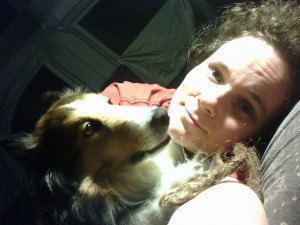 Every night when we enter the tent to go to bed, our dog Tuatha goes with. But he only lasts a few minutes before nuts from the trees above start falling and hitting the tent. Tuatha goes into panic mode and insists we evacuate. And when we show no interest, he scratches on the door of the tent, every dog for himself.
Every night when we enter the tent to go to bed, our dog Tuatha goes with. But he only lasts a few minutes before nuts from the trees above start falling and hitting the tent. Tuatha goes into panic mode and insists we evacuate. And when we show no interest, he scratches on the door of the tent, every dog for himself.
At this point, C.T. calls him scaredy-cat, to which Tuatha has no objection, as long as he can get back into the cabin to spend the night hiding under large heavy furniture. Tuatha apparently prefers the threat of snakes in the house to bombs from above.
For the past few nights, the bombings have been particularly frequent. As a matter of fact, C.T. and I could swear that the nuts are being thrown, not just dropping. They hit so hard. And, here’s the kicker, they’re coming in sideways!
“Maybe the squirrels are annoyed by our lamp and want us to turn out the light,” C.T. guessed.
 “Squirrels are going to stay in their homes at night. They’re not going to risk getting eaten just to throw nuts at us,” I countered. “Although flying squirrels are nocturnal…” We did have a flying squirrel slam into the tent side a couple of nights before.
“Squirrels are going to stay in their homes at night. They’re not going to risk getting eaten just to throw nuts at us,” I countered. “Although flying squirrels are nocturnal…” We did have a flying squirrel slam into the tent side a couple of nights before.
“Maybe they’re frightened or annoyed or jealous of all the sounds we’re making,” C.T. continued, referring to our tendency to be very vocal during sex.
I tried to imagine a squirrel or raccoon with inadequacy issues. “Frightened, maybe,” I answered. “I guess we’re the noisy neighbors of the woods.”
Still we couldn’t place the source or catch anyone in the act. I started pondering the period of time about three years ago when we had other odd occurrences at Heathcote.
I recalled walking in the woods with the Open Classroom kids when we came upon a mass of some almost alien looking substance on the ground, a few feet from the entrance to a small cave. The stuff was greenish-yellowish, slightly more firm than gelatin and in a pile on the leaf litter. There was about a gallon of it.
Was it some kind of fungus or giant frog egg cluster? We couldn’t find any attributes that identified the mass. We were left with only one conclusion, given it’s proximity to the cave: Dragon snot.
 This was the beginning of several months of sightings, almost-sightings, alleged sightings and many clues discovered and debated. At first most of the reports came from kids. But eventually adults also came forward with stories of dragon sightings in the Heathcote forest.
This was the beginning of several months of sightings, almost-sightings, alleged sightings and many clues discovered and debated. At first most of the reports came from kids. But eventually adults also came forward with stories of dragon sightings in the Heathcote forest.
I myself was startled by the dragon up at  Bill Anacker’s house once. I ran a twisted course through the swings in Bill’s yard, barely making it to the front door. The dragon was on my heels so near, that I had to dive trough the oversized doggie door. I didn’t even have time to turn a door knob!
Bill Anacker’s house once. I ran a twisted course through the swings in Bill’s yard, barely making it to the front door. The dragon was on my heels so near, that I had to dive trough the oversized doggie door. I didn’t even have time to turn a door knob!
Over time, sightings became less frequent. I haven’t heard of any lately. But now, with this anomalous event of nuts, dirt clumps and feces being thrown at our tent, I wonder.
There’s nothing like a tent, made of polyfiber only a couple of millimeters thick, staked under fifty-foot trees in a hundred acre wood, to give one pause about one’s place in nature and the food chain. Turn out the light, listen to the quiet of the night, then have it disturbed by tiny bombs, bombs that have been falling to Earth every year for millenia.
For millenia, animals like me have been discovering dragons.
—WT
Please join our Hippie Chick Diaries fan page on Facebook!
Bunny & Box Turtle Crossing
 As I finished making signs to post around Heathcote, advertising my porch sale, my dog Tuatha took advantage of my distraction to slip away for a little “me time” adventure.
As I finished making signs to post around Heathcote, advertising my porch sale, my dog Tuatha took advantage of my distraction to slip away for a little “me time” adventure.
Tuatha knows this distresses me. I want to keep him safe, away from car wheels and copperheads. But I have to admit that, on a hot June day like today, I’d love to slip away and play in the stream, too.
So I loaded my signs and myself into the car and went looking for him. When he runs away, I always have to talk to myself to remain calm and methodical.  Once when I let my anger express itself in driving down the road much too fast, I ran over a groundhog. I felt horrible. And, of course, I realized that it could have been my own lost dog that I killed in an out-of-control moment.
Once when I let my anger express itself in driving down the road much too fast, I ran over a groundhog. I felt horrible. And, of course, I realized that it could have been my own lost dog that I killed in an out-of-control moment.
And today I remembered that awful moment as I talked myself into calm, remembered that I’ve always found him quickly in the past, that he’s much more woods-savvy than I give him credit for, and that I can help him best by breathing and staying connected to my surroundings.
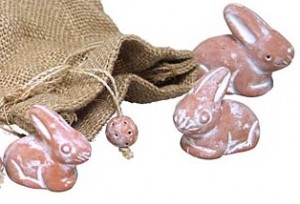 The Universe likes to reinforce these messages, apparently. As I drove around looking for him, driving at a reasonable speed, a rabbit in the road had one of those squirrel moments and zig zagged under my car. But I was in control and managed to not injure it. Later, on a dirt road, a box turtle was well camouflaged as it walked in the rut. If I weren’t paying attention, I would have flattened it. Instead I moved it.
The Universe likes to reinforce these messages, apparently. As I drove around looking for him, driving at a reasonable speed, a rabbit in the road had one of those squirrel moments and zig zagged under my car. But I was in control and managed to not injure it. Later, on a dirt road, a box turtle was well camouflaged as it walked in the rut. If I weren’t paying attention, I would have flattened it. Instead I moved it.
 Hares and tortoises. I get it. Even The Universe speaks in cliches .
Hares and tortoises. I get it. Even The Universe speaks in cliches .
Of course, my dog was safe in the bowl of Heathcote the whole time. and I caught up with him at our usual rendezvous point, Bill Anacker’s house. He was dripping wet from cooling off in the stream. I couldn’t be mad at him. Okay, I was still a little, but that’s my stuff…
This is the second time in a week Tuatha has snuck off. I am slow to get the message, but I wonder if there’s a way I can help him cool off while staying safe at home. He loves to play in the hose, but if I could find a little yard sale kiddie pool, he could self select. How about that, Tuatha?
Please join our Hippie Chick Diaries fan page on Facebook!
Social Technology Toolbox Summer Camp July 15-24, 2011
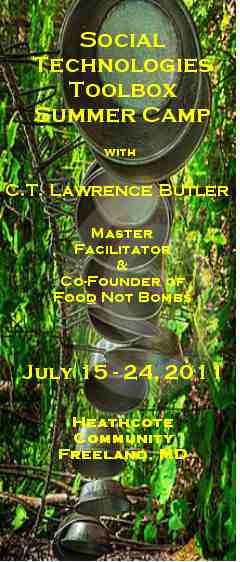
 How did we come up with the idea for a toolbox summer camp? C.T. Butler and I have been exploring how Intentional Communities and other groups succeed and how they understand (or often misunderstand) consensus. The idea of a “toolbox,” which members regularly update and use to build new culture, solve conflicts and grow as people, isn’t a new idea. What goes in it varies but adding to it seems key.
How did we come up with the idea for a toolbox summer camp? C.T. Butler and I have been exploring how Intentional Communities and other groups succeed and how they understand (or often misunderstand) consensus. The idea of a “toolbox,” which members regularly update and use to build new culture, solve conflicts and grow as people, isn’t a new idea. What goes in it varies but adding to it seems key.
More than just a technique like Non-Violent Communication, “consensus is a cultural paradigm…a way of being in the world,” writes trainer Maikwe Schaub Ludwig. Yet few people get much more than a day or two of training in this “way of being.” Many more find themselves practicing it with no training!
A space happened to open up in Heathcote Community’s education calendar. And when C.T. and I considered it for a weekend slot, we realized we had the chance to really help people go deep and get it!
We sprang into action and put together many of the ideas we’d been collecting. Ta dah! Toolbox Camp!
Below is the text of our brochure:
Are you currently part of an organization, activist group, non-profit, Cohousing or Intentional Community that’s having trouble with governance, decisionmaking or communication?
• Does your group feel a time pressure when making decisions?
• In discussions, does everyone speak?
• Does your group accomplish its goals?
• Do some people dominate? Is there burnout?
• Is the workload uneven? Organizational structure vague?
• Does it seem members just don’t hear each other?
C.T. Butler and Wren Tuatha been going deeper into the nature of consensus, how to teach it and how to help groups succeed. We’ve gotten clear that consensus is amazing and transformative, but that it’s a major paradigm shift for most groups. It’s more than just exchanging Robert’s Rules for Butler’s. C.T. isn’t just offering new software, so to speak, but a whole new operating system.
We are offering these skill building experiences designed to help Communities, activist groups, non-profits, spiritual groups, families, etc., succeed in their goals through awareness of the structures of group dynamics—decisionmaking, conflict resolution, mediation, listening, and communication that integrates head, heart and gut.
SOCIAL TECHNOLOGY TOOLBOX SUMMER CAMP
July 15-24, 2011
A 10 day immersion, starting with a weekend workshop called Consensus, Body and Soul. Then, together, we’ll create temporary consensus-based community. The mornings will be devoted to ZEGG Forum and deeper consensus workshops. Each 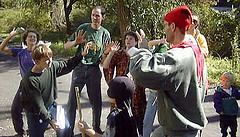 afternoon, we will add techniques and perspectives like Enneagrams, JoHari Window, Spiral Dynamics, Heart of Now, etc. The group will make decisions together at plenaries and participants can offerπ content of their own each evening through Open Space Technology.
afternoon, we will add techniques and perspectives like Enneagrams, JoHari Window, Spiral Dynamics, Heart of Now, etc. The group will make decisions together at plenaries and participants can offerπ content of their own each evening through Open Space Technology.
Simply, we’re all about finding the voice of the group. After thirty years in the field of consensus, C.T. presents a clear vision of egalitarian freedom through use of structure that brings the common values to life within the group.
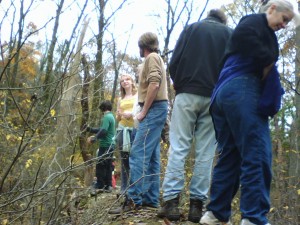 Some lessons are collected from other wise travelers, others are plucked from our own experiences in groups. Even as we make our offerings, the paradigm is leaderless and participant generated. We are curious about you. What do you bring?
Some lessons are collected from other wise travelers, others are plucked from our own experiences in groups. Even as we make our offerings, the paradigm is leaderless and participant generated. We are curious about you. What do you bring?
LOGISTICS
Request a brochure with the application form at curiocoast@comcast.net. Costs include fixed fees for materials, food and lodging, and a sliding scale for tuition.
Structured programming begins Friday evening, July 15. and ends at noon on Sunday, July 24. Lodging options are camping and the Heathcote Mill bunkroom. 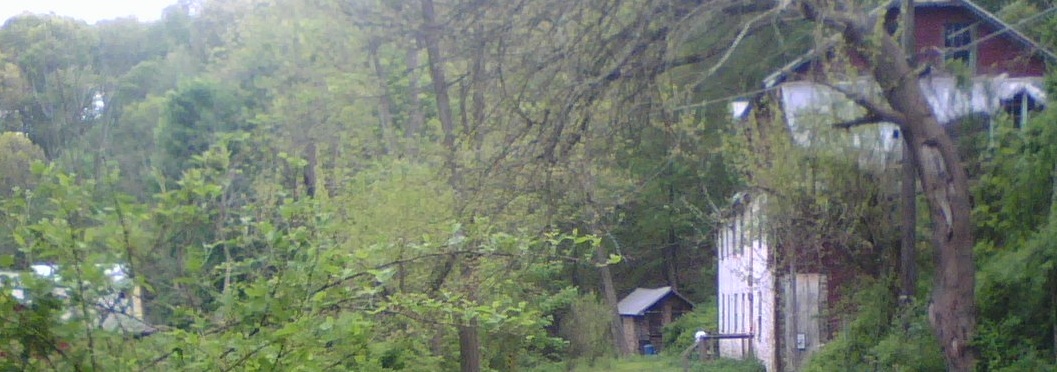 Accommodations are rustic and, like most forests, the land does have poison ivy/oak and ticks that carry lyme disease. Heathcote is a vegetarian facility, and drug and alcohol free. Carpooling is encouraged. You will receive a packet with directions, a Heathcote orientation, packing lists, schedules and other logistics upon registration. The packet will include requests for food allergy and other special needs information.
Accommodations are rustic and, like most forests, the land does have poison ivy/oak and ticks that carry lyme disease. Heathcote is a vegetarian facility, and drug and alcohol free. Carpooling is encouraged. You will receive a packet with directions, a Heathcote orientation, packing lists, schedules and other logistics upon registration. The packet will include requests for food allergy and other special needs information.
Please join our Hippie Chick Diaries fan page on Facebook!



